Volume 84 - May 15, 2015
It’s the season of green! All of Iwate has come alive with summer greenery.
The Kosode Ama Center re-opens at the location of the 2013 NHK Drama "Ama-chan" (Kuji)
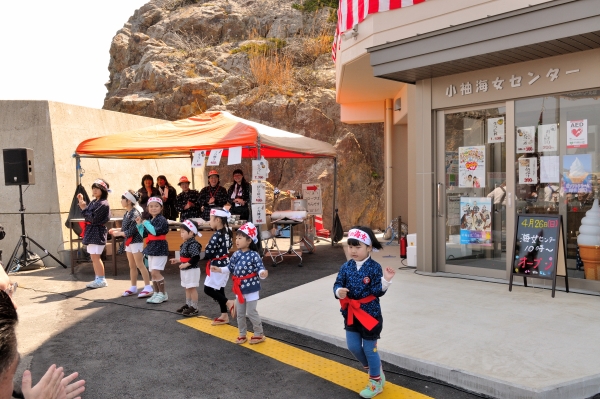
At Kuji City’s Kosode Beach, famous as the location for the popular 2013 NHK morning drama Ama-chan, the Kosode Ama* Center has been rebuilt following its destruction by the Great East Japan Earthquake and Tsunami. On Sunday, April 26, 2015, it was officially reopened in advance of the summer tourist season.
A grand opening ceremony was held on the same day. “Kuji is now an international tourist hotspot thanks to the production of Ama-chan, and so I want many more people to come and enjoy Kuji’s beautiful scenery and delicious seafood,” said Joji Endo, Mayor of Kuji, at the ceremony. They also gave out mochi rice-cakes at the event and a dance was performed by the Kiddy Ama Corps in order to commemorate the Center’s reopening.
The newly-opened Center is a three-story building made of reinforced concrete. The first floor is the fresh foods and souvenir space; the second floor is the exhibit space that describes the history and culture of the ama of the northern coast; the third floor is the “Ama Café” where drinks and snacks are sold. There is also an observation deck on the roof, with a great view of the bay.
The Kosode Ama Center is open 9 a.m. to 5 p.m., and from July 2015 there will also be live diving and fishing performances by local ama. It is hoped that the revival of this facility will encourage both Japanese and foreign tourists to come and visit Kuji.
*Ama: female divers who often harvest sea urchin
(Photograph courtesy of Kuji Municipal Government)
Reconstruction Support - The SL Ginga Train Opens Its Doors (Hanamaki - Kamaishi)
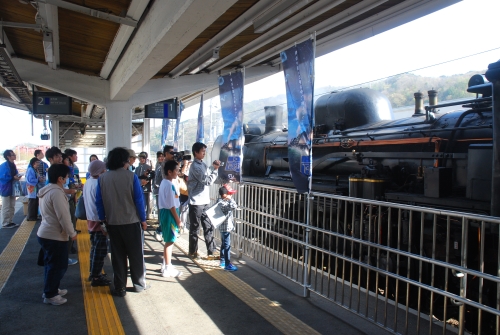
April 25 was a sunny Saturday during Golden Week, and saw an old-style steam engine “SL Ginga” make its first run of 2015 on the JR Kamaishi Line (Hanamaki Station to Kamaishi Station, 90.2 km). The SL Ginga is a restoration of the steam train C-58239 that was decommissioned roughly 40 years ago. It was brought back by JR East in order to encourage the reconstruction in the regions that were badly affected by the Great East Japan Earthquake and Tsunami.
The train ran on Saturdays, Sundays, and public holidays last year from April to December, and was enjoyed by roughly 12,400 passengers. This is its second year in operation.
April 25 was its first day of operations this year, and around 170 people were packed in before it left Hanamaki Station. The almost-full steam train set out for Kamaishi Station with a chirp of its steam whistle. The SL Ginga arrived at Kamaishi Station a little after 3 p.m. and was welcomed by a traditional Kamaishi Tiger Dance. The Sanriku specialty mekabu-jiru (soup made from thick wakame seaweed stalks) was provided free of charge, welcoming all of the passengers to the region.
The SL Ginga will run again this year on Saturdays, Sundays, and public holidays, and support the reconstruction by encouraging tourism in the affected region.
Sanriku-Yamada Oyster Festival

On Wednesday, April 29, 2015, the Sanriku-Yamada Oyster Festival was held in the Yamada Fish Market by the Yamada-no-Miryoku Committee. The festival was held for the second time (the first being last year) since the Great East Japan Earthquake and Tsunami.
Oysters-in-the-shell, scallops and other sea food of Yamada were sold at an affordable price, with a huge line for the free oyster soup (only 400 servings). Many people from both within and outside Yamada gathered to taste the area’s delicious spring catch of oysters.
There was also a barbecue corner where visitors could grill the seafood products they bought, as well as a game corner where they could try their hand at using a fish hook to scoop oysters and scallops out of a fish tank. The event really showed a close-up view of the recovery of Yamada’s fisheries.
(Photograph courtesy of Yamada Tourism Association)
Shrine festival revived after an 8-year hiatus (Ofunato)
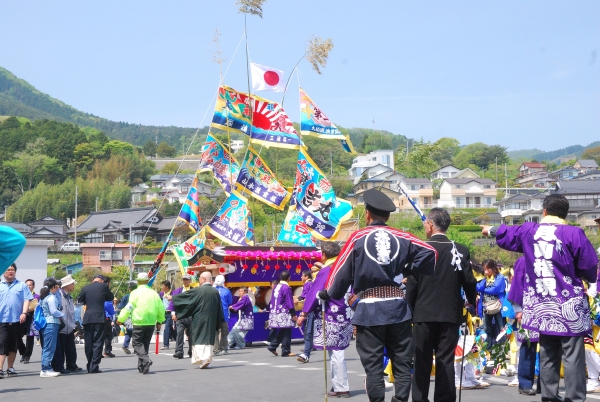
In hopes for reconstruction and to pass on local traditional performing arts, the Kamo Shrine in the Ofunato district of Ofunato City held its Quadrennial Grand Festival in the same district.The festival is held once every four years, and was planned for 2011 but was called off because of the Great East Japan Earthquake and Tsunami, and so when it was held on Sunday, May 3, 2015, it was the first time in eight years.
This year’s festival saw a parade of young children wearing dazzling costumes, mikoshi shrine palanquins, and feudal lords walking through the central part of the city, which is still under construction, and the temporary shopping district. At the main venue — the Ofunato Fish Market — gongen-mai and shishi-odori dances were performed along local performing arts from ten districts in the city.
The shrine palanquin was also hoisted out on the sea by some 30 fishing boats flying colorful banners as part of a water-crossing ritual that prays for a big fish catch.
Features

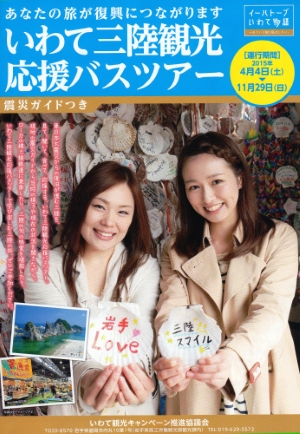
Iwate Sanriku Tourism Support Bus Tours
Operating Period: April 4 (Saturday) to November 29 (Sunday)
Course 1→ Sanriku Railway, Goishi Beach and the Miracle Lone Pine Tree (Iwateken Kotsu)
Course 2→ Sanriku Railway and The Miracle of Kamaishi DRR Learning Journey (Hanamaki Sightseeing Bus)
Course 3→ Jodogahama Beach, Taro Area, Ryusendo Cave (Northern Iwate Transportation)
Course 4→ Je je je! Kuji, Homeland of the Northern Divers of Kitasanriku, and Sanriku Railway
* Course 4 has two tours going to different places (Northern Iwate Transportation)
Your travels can help the reconstruction
The Sanriku Coast is moving steadily toward reconstruction. These bus tours give a rich travel experience by teaching passengers about the disaster and reconstruction progress. It also runs to various sightseeing
and local goods venues.

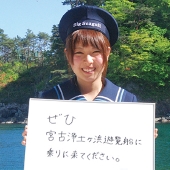
Many young people are diligently helping the affected area of Sanriku move toward a full reconstruction. The section “People for Sanriku’s Future” introduces these young people and their powerful feelings.
Click the link to read about Aoi Yokoyama and her journey to become a tour boat guide.
Casualties and Damage in Iwate (as of April 30, 2015)
- Human casualties/deaths: 4,672; Missing: 1,129
- Buildings destroyed (residences only, total/partial): 26,163
Thank you for all of your support! (as of April 30, 2015)
Donations for survivors: Around 18.38074 billion yen (91,452 donations)
Donations for reconstruction projects: Around 19.67782 billion yen (7,305 donations)
Iwate Learning Hope Fund donations: Around 7.31347 billion yen (15,346 donations)
※ This fund is to assist in the study and daily life of affected
children by encouraging sport and study activities.
Contact
News from Iwate’s Reconstruction, Volume 84. May 15, 2015.
Published by the General Affairs Division, Bureau of Reconstruction, Iwate Prefecture.
Phone: 019-629-6925
Editing & Printing: SYNAPSE
*News from Iwate's Reconstruction Volume 85 will be published on June 1.
PDFファイルをご覧いただくには、「Adobe(R) Reader(R)」が必要です。お持ちでない方はアドビシステムズ社のサイト(新しいウィンドウ)からダウンロード(無料)してください。
このページに関するお問い合わせ
Office of International Affairs, Department of Homeland Promotion
(020-8570) 10-1 Uchimaru, Morioka City, Iwate Prefecture, JAPAN
Phone number:019-629-5765 Facsimile:019-629-5254
You can access our question form here.

